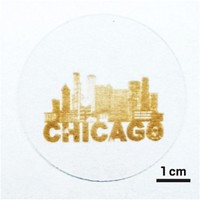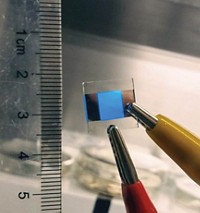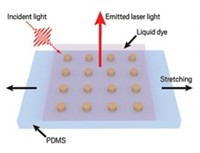Advertisement
Grab your lab coat. Let's get started
Welcome!
Welcome!
Create an account below to get 6 C&EN articles per month, receive newsletters and more - all free.
It seems this is your first time logging in online. Please enter the following information to continue.
As an ACS member you automatically get access to this site. All we need is few more details to create your reading experience.
Not you? Sign in with a different account.
Not you? Sign in with a different account.
ERROR 1
ERROR 1
ERROR 2
ERROR 2
ERROR 2
ERROR 2
ERROR 2
Password and Confirm password must match.
If you have an ACS member number, please enter it here so we can link this account to your membership. (optional)
ERROR 2
ACS values your privacy. By submitting your information, you are gaining access to C&EN and subscribing to our weekly newsletter. We use the information you provide to make your reading experience better, and we will never sell your data to third party members.
Materials
Organic Lasers Shine Bright In The Infrared
Materials: Easy-to-build hemispheres could prove widely useful for lasing applications
by Neil Savage
July 22, 2015

Lasers that emit near-infrared light are important for many applications, from optical telecommunications to biomedical imaging. If they could be built out of organic molecules, they’d be cheaper and easier to make. So far, however, attempts to make organic solid-state lasers at those wavelengths have yielded devices too dim to be useful. Now researchers have shown they can fabricate organic near-IR lasers that emit much more light (J. Am. Chem. Soc. 2015, DOI: 10.1021/jacs.5b03051).
Hongbing Fu, a physical chemist at the Chinese Academy of Sciences, in Beijing, and colleagues first created a compound with the right electronic properties to emit in the near-infrared. They reacted 2-acetyl-1-naphthol with 4-(di-p-tolylamino)benzaldehyde to form a pi-conjugated small molecule, DPHP. A hydrogen bond within the molecule shifts the emission wavelength to the desired near-IR region.
DPHP’s “propeller-shaped” geometry boosts the efficiency with which excited electrons emit photons, the researchers say. In previous organic lasing materials, the excited electrons would often collide and lose some of their energy before they could emit a photon, leading to less photoluminescence. In a DPHP crystal, the excited electrons decay and emit photons an order of magnitude faster, thus increasing the odds they’ll produce a photon before bumping into one another and quenching their emission.

To create lasers, the researchers dissolved DPHP in dichloromethane, mixed in some water, and placed drops of the solution on a glass slide. The solvents evaporated, leaving solid hemispheres ranging from about 2 to 14 µm in diameter. The microscopic domes act as the laser cavities that amplify the light.
When fired with a 400-nm blue laser, the hemispheres emitted light in the 760-nm range, demonstrating that lasing occurred within the domes. Different input energies produced different output wavelengths. The hemispherical shape, Fu says, produces an effect known as “whispering gallery mode,” in which the light waves moving along the surface of the dome enhance each other; the same effect allows whispers to travel and be heard on the opposite side of the large dome of London’s St. Paul’s Cathedral. The lasers showed a photoluminescent efficiency of approximately 15.2%, a vast increase over the 1% of previous organic lasing molecules, though the researchers would like to improve it further.
Although the work demonstrates that near-IR organic lasers are possible, they’re not yet practical. As with other early-stage laser technologies, this system currently relies on light produced by another laser, and it won’t be commercially viable until it runs directly on electricity. “Electrically pumped organic lasers still remain a great challenge,” Fu says.
Hong-Bo Sun, who heads the Center for Ultrafast Optoelectronic Technologies at Jilin University, in China, says Fu’s lasers would be much less expensive and complex than inorganic semiconductor lasers, and show promise for applications such as optical sensors on biochips. Before they can be practical, he says, researchers will have to figure out a number of issues, such as how to precisely control the size of the hemispheres or the direction in which light comes out.





Join the conversation
Contact the reporter
Submit a Letter to the Editor for publication
Engage with us on Twitter